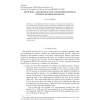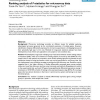76 search results - page 9 / 16 » Linear-Time Ranking of Permutations |
JCSS
2002
13 years 7 months ago
2002
Hannenhalli and Pevzner [5] gave a polynomial time algorithm for computing the minimum number of reversals, translocations, fissions, and fusions, that would transform one multichr...
TSP
2011
13 years 2 months ago
2011
—Ranking data is a type of data obtained in some elections, in customer surveys, as well as from web search results. Such data may be considered as a type of signal defined on t...
AAAI
2006
13 years 9 months ago
2006
Voting (or rank aggregation) is a general method for aggregating the preferences of multiple agents. One important voting rule is the Slater rule. It selects a ranking of the alte...
ICML
2007
IEEE
14 years 8 months ago
2007
IEEE
The paper is concerned with learning to rank, which is to construct a model or a function for ranking objects. Learning to rank is useful for document retrieval, collaborative fil...
BMCBI
2008
13 years 7 months ago
2008
Background: Microarray technology provides an efficient means for globally exploring physiological processes governed by the coordinated expression of multiple genes. However, ide...


